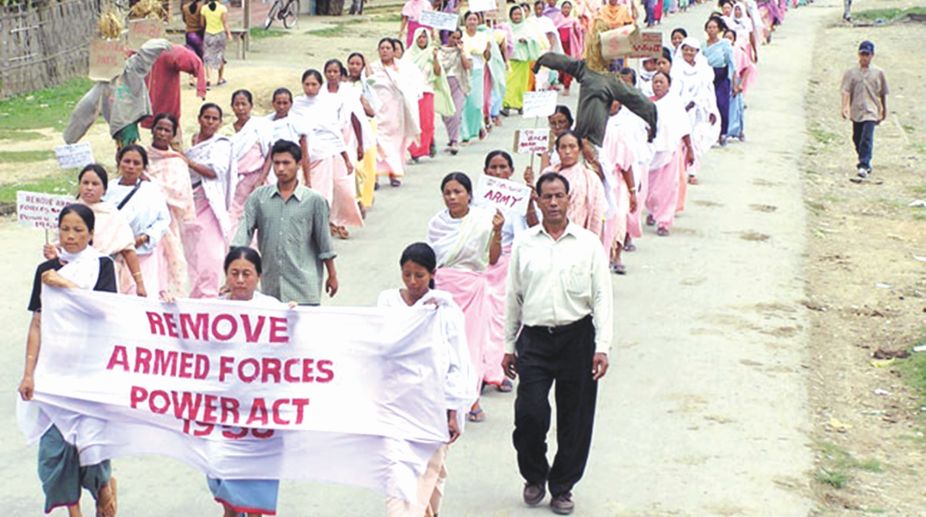The Armed Forces Special Power Act (AFSPA), which has defined North East India for the last six decades since 1958 within a frame of ‘exception’ is gradually losing its relevance with the changing perceptions of the region. With the recent announcement of its complete removal from Meghalaya with effect from 31 March 2018, AFSPA has now been revoked from three states including Tripura and Mizoram. It was basically a relic from colonial times, dating back to 1942. Nagaland after the signing of Peace Accord in the near future may be the next to be an AFSPA- free state in the region.
An AFSPA-free North-east is becoming a reality as the region is transforming itself to become an ‘economic hub’, while violent militancy is gradually fading away. The region since independence was reckoned as an ‘exception’ to India’s idea of statehood to become a police state.
Advertisement
The draconian AFSPA was imposed and implemented on 11 September 1958 in Assam and Manipur and was amended in 1972 to extend to all other states of the North-east which were curved out of Assam under the North Eastern Area Reorganisation Act, 1971. Beset by armed secessionist movements opposing integration with India in the post-colonial period, the entire region was declared as ‘disturbed’.
It posed a serious challenge to the Indian administration for many decades.
Over time, most of these movements which sprang from an independent identity concern based on the territoriality and ethnicity of people in the region have petered out and lost their appeal.
Persistent negotiations have resulted in about 14 peace accords between 1949 and 2015, and another Naga Peace Accord is on the way to be signed before the general election of 2019. In this long arduous journey, AFSPA continued to remain the most dreadful and contentious law in the region, under which the Indian Army was given unlimited power to shoot, arrest and search with impunity, all in the name of ‘law and order’ issue.
This created a deep divide and scourge across the North-east. There has been persistent protest amongst the citizens to revoke it and find political solutions to the problem instead. Irom Sharmila of Manipur became one such symbol of protest for sixteen long years since the year 2000. In her late twenties, she had taken a vow to fight against such a law and restore normalcy to her fellow citizens in Manipur. Her youth and energy have been sacrificed but the goal was never reached in her state.
Incidence of violence is one of the parameters for Ministry of Home Affairs to monitor internal security issues. This is now declining fast in the North-east. During the period 2007-2017, the number of such incidents came down from 1489 to merely 308 a year. In 2017, both Mizoram and Tripura had zero incidents, while Assam, Arunachal Pradesh, Meghalaya and Nagaland reported 33, 61, 28 and 19 cases respectively.
Manipur topped the list with 167 reported cases. If these numbers can be considered as signs of restoration of stability and peace, then the region certainly reflects hope. Thousands of lives were lost in the last six decades in various counter-insurgency operations and AFSPA got blanket support of the State to militarize the region and create threats to everyday life.
Even though the number of incidents has gradually come down, the price extracted in terms of human life was still steep in the last decade; 5,207 people lost their lives, including 2,920 extremists, 1,975 civilians and 312 military personnel. These deaths have left deep scars on the social landscape of the region, especially amongst women and youths. This has also stereotyped the image of the region as ‘disturbed’, characterised by the absence of normal ‘law and order’.
As most of the State policies and measures were intertwined and framed within the logic of security in the North-east, the share of Central funds spent on such security-related issues also rose over time. Between 2006-07 and 2016-17, expenditure on security had almost doubled from Rs 153 crore to Rs 300 crore.
As India’s much hyped Act East Policy now focuses on creating a robust connectivity infrastructure within the North-east and beyond for boosting gainful transnational economic activities, peace is a prerequisite. With the emphasis on such open economy, the geography of North-east is becoming significant for India’s regional engagement with neighbouring nations of East and Southeast Asia.
Rs 1 lakh crore has been allocated for road infrastructure in NEI, and the ‘grammar of commerce’ is bringing political forces from both the Union and the state governments in the region together to transform the North-east from decades-old isolation to the role of a ‘connecting gateway’. In such a scenario, AFSPA is an impediment, the removal of which will surely be celebrated by the people of every state in this region.
The writer is on the faculty of Jawaharlal Nehru University, New Delhi.











